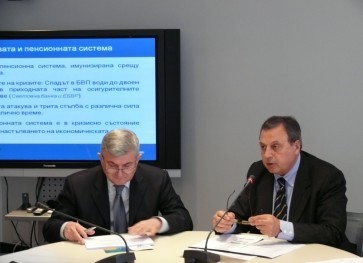SOCIAL SECURITY RATE CUTS LIKELY TO BE SHELVED
Focus now shifts to changes in very pension model
The pension reform in Bulgaria seems to have got stuck. After the government abandoned its plans to increase the retirement age, there appeared signs that social security contributions will most probably not be cut 1 percentage points in each of the next three years as mulled.
We need more time to see the effect of the raised minimum social security income for the self-employed and the effect of the reduction in the contribution rate by 2%, deputy minister of labour and social policy Hristina Mitreva pointed out. In her words, if pension system revenue fails to increase, the government may renounce its decision to further cut security rates.
Pros & cons
The reduction in security contributions in times of crisis is criticised by nearly all experts in the consultative council on the pension reform system, council member Grigor Dimitrov said. If the rate is cut 2 percentage points in 2010, social security collections will fall BGN 300 million. Such a gap is almost impossible to fill, given the slump in employment and wages in the real sector, he added.
Employers' organisations themselves are not unanimous on the problem. The reduction in social security contributions should continue until 2013, as the government promised, Bulgarian Industrial Capital Association chairman Vasil Velev underscored. That is already included in Bulgaria's convergence programme for development, i.e. it is a commitment made to Brussels, Confederation of Employers and Industrialists in Bulgaria (CEIB) chairman Ivo Prokopiev reminded.
There is no employers' organisation that does not want a reduction in social security rates but that can be dangerous in a crisis, the Bulgarian Industrial Association (BIA) pointed out. The chasm between the system's revenue and expenditure is widening and the only way to bridge it is increasing the subsidy from an already tough state budget, BIA chairman Bozhidar Danev said. The deficit of the state social security fund in 2010 amounts to BGN 2.3 billion, i.e. it is 23 times as big as in 2000, he added.
Model
We are not giving up our plans for pension reform. The consultative council continues discussing measures to stabilise the system and secure adequate pensions to senior citizens, minister of labour Totyu Mladenov underscored. The focus will now shift to the very model of reform, a Pari daily's inquiry shows.
According to BIA, the philosophy and essence of the three-pillar pension security model should be preserved. The first pillar is state social security, which is funded by the contributions of the employed and used for pensions of the currently retired on a solidarity principle. The second pillar is mandatory insurance with a private pension fund operating on a fully-funded principle. The third pillar is voluntary insurance with such a fund.
There is nothing wrong about covering state pensions with tax revenue, rather than with social security contributions, Velev commented. According to CEIB, now that the retirement age increase has been shelved, the government should consider more radical measures for changes in the pension system, such as introducing a fully-fund scheme for the first pillar. That, however, has been severely criticised by trade unions. The experts in the consultative council are not unanimous either.









